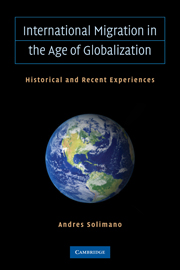Book contents
- Frontmatter
- Contents
- Acknowledgments
- 1 Introduction: Understanding the Trends, Themes, and Strata of International Migration
- 2 Why People Move or Stay Put: International Migration Is the Result of Compelling and Conflicting Factors
- 3 What Happens When International Migration Happens? The Dilemmas Posed by Migration
- 4 How Empires, Policy Regimes, and Economic Imperatives Influenced the Mobility of Capital and People in the 20th Century
- 5 Latin America: Where Volatile Economic Development, Political Crises, Poverty, and Remittance Income Is a Laboratory for Studying the Determinants of International Migration
- 6 Who Migrates and What They Offer: A Focus on People and Elites with Talent, Knowledge, and Entrepreneurial Skills
- 7 A Fair and Orderly International Migration Process Requires a Global Social Contract
- References
- Index
2 - Why People Move or Stay Put: International Migration Is the Result of Compelling and Conflicting Factors
Published online by Cambridge University Press: 05 June 2012
- Frontmatter
- Contents
- Acknowledgments
- 1 Introduction: Understanding the Trends, Themes, and Strata of International Migration
- 2 Why People Move or Stay Put: International Migration Is the Result of Compelling and Conflicting Factors
- 3 What Happens When International Migration Happens? The Dilemmas Posed by Migration
- 4 How Empires, Policy Regimes, and Economic Imperatives Influenced the Mobility of Capital and People in the 20th Century
- 5 Latin America: Where Volatile Economic Development, Political Crises, Poverty, and Remittance Income Is a Laboratory for Studying the Determinants of International Migration
- 6 Who Migrates and What They Offer: A Focus on People and Elites with Talent, Knowledge, and Entrepreneurial Skills
- 7 A Fair and Orderly International Migration Process Requires a Global Social Contract
- References
- Index
Summary
People migrate from one nation-state to another, the nation-state being the natural, defining point of origin and destination for international migration flows. Nations are defined by borders, history, culture, legal systems, language, standing national armies, and national currency. Thus, if the number of nation-states increases over time – as it has in the 20th century, growing from 74 countries in 1946 to 192 United Nations–member countries in the early 21st century – the nature, characteristics, and direction of international migration flows will shift. In fact, some migration that was formerly internal has become international, because many more countries have divided in the past few decades than have unified. Thirty-three new countries were created after the collapse of the socialist block in Eastern Europe and the former Soviet Union in the late 1980s and early 1990s. And, although East Germany and West Germany unified in 1990, Czechoslovakia split into the Czech Republic and Slovakia in 1993, and Yugoslavia split into Bosnia, Croatia, Macedonia, Serbia, Montenegro, and Slovenia in the early 1990s. With the disintegration of the former Soviet Union, 15 new independent states were created that were once former Soviet republics. The increase led to a surge of between 5 and 10 million “international” migrants among former Soviet republics, according to the World Bank. Historically, as we will show in Chapter 4, major wars and the dissolution of empires have been the turning points for changes in the number of countries.
- Type
- Chapter
- Information
- International Migration in the Age of Crisis and GlobalizationHistorical and Recent Experiences, pp. 22 - 40Publisher: Cambridge University PressPrint publication year: 2010



